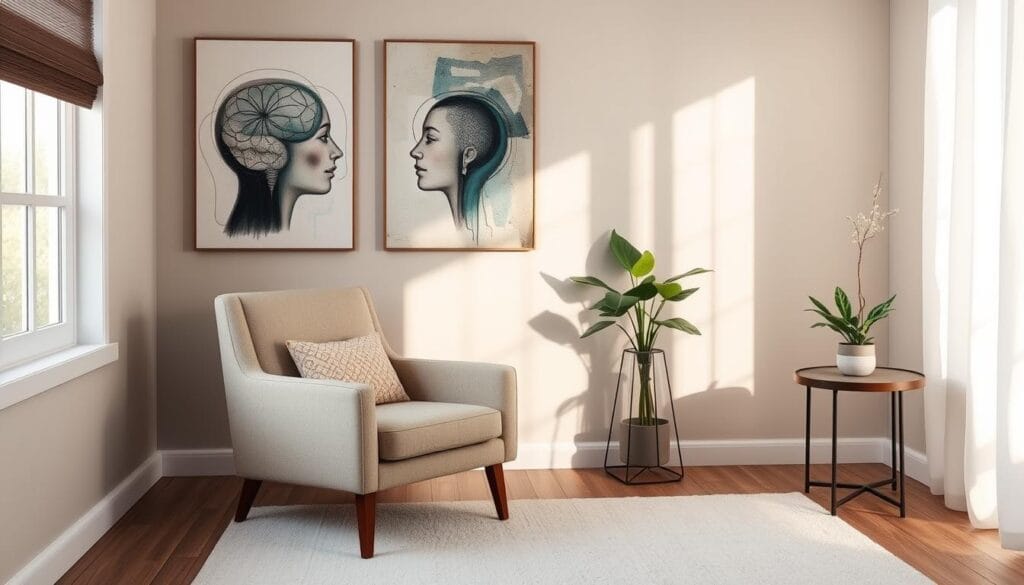Depression can feel like a dark cloud that overshadows every aspect of your life. But, you have more power to fight it than you might think. Taking proactive steps to manage your mental health can make a big difference.
In my own journey with depression, I’ve learned that small, consistent actions can lead to profound transformations. By sharing my personal experiences, I hope to inspire you to embark on a path of healing and reclaim your joy.
Table of Contents
Understanding Depression as a Medical Condition
Depression is a complex mental health issue that affects millions globally. It’s caused by genetics, biology, environment, and psychology. Knowing the signs, symptoms, and causes is key to beating this treatable illness.
Common Signs and Symptoms
Depression’s main signs include feeling sad all the time and losing interest in things you used to love. You might also feel very tired, have trouble focusing, and sleep or eat differently. Some people even think about death or suicide.
Biological and Environmental Factors
Studies link depression to brain chemistry imbalances, like serotonin and dopamine. Hormonal shifts, chronic illnesses, and stress can also play a role.
Why Depression Affects Everyone Differently
Depression hits people in unique ways. Genetics, gender, age, and life events shape how it shows up. For instance, hormonal changes can lead to depression in women, especially during pregnancy or before their period.
Depression touches about 17.3 million adults in the U.S., or 7.1% of the adult population. Women are more likely to experience it, with 8.7% of females versus 5.3% of males. Some types of depression, like seasonal affective disorder, are more common in certain areas or times.
“Depression is a highly complex condition that requires a multifaceted approach to treatment. By understanding the underlying factors and how depression can manifest differently in each individual, we can develop more effective strategies to overcome this challenge.”
The Importance of Social Connection and Support
Reaching out and staying connected is key to overcoming depression. Depression can make it hard to ask for help, but connecting with others can really help. Try to make face-time a priority, keep up with social activities, and support others. Joining support groups and talking to trusted people can also help. Even pets can offer companionship and a sense of purpose.
Being connected to others makes us feel like we belong and are loved. Social bonds are vital for our mental and physical health. People with strong social ties tend to live longer and healthier lives.
Connecting with others can lower the risk of serious diseases like heart disease and depression. It helps us manage stress better, eat healthier, and sleep better. Healthy relationships encourage us to make choices that boost our mental and physical health.
Communities are key in building supportive connections. They help us trust others, become resilient, and fight loneliness. Creating these connections is vital for dealing with life’s challenges and getting emotional and physical support.
“Cultivating diverse social networks is crucial for comprehensive mental wellness, as different types of relationships such as friendships, family, romantic partnerships, and community networks offer unique benefits and challenges.”
Studies show that social connections greatly improve mental health. They help reduce stress, build resilience, and enhance our quality of life. On the other hand, being alone can harm our mental health, increasing the risk of depression and anxiety.
To beat depression, focus on building social connections and seeking support. By nurturing good relationships and participating in social activities, we can enjoy the many benefits of being connected. This improves our mental well-being.
Overcome Depression Through Physical Activity
Regular physical activity is a powerful tool against depression. Studies show it can be as good as medicine in easing symptoms. It’s a key part of a full mental health plan.
Benefits of Regular Exercise
Exercise releases endorphins, serotonin, and dopamine, which make you feel better. It also boosts self-esteem and well-being through social interaction and achievement.
Types of Mood-Boosting Activities
- Aerobic exercise, like brisk walking or swimming, is very effective against depression.
- Strength training, done 2-3 times a week, is as good as aerobic exercise in fighting depression.
- Yoga, focusing on mindfulness, also lowers depression and anxiety.
Starting Small with Movement
Start with small steps to fight depression through exercise. Begin with 5-10 minutes of gentle activity daily. Gradually increase to 30 minutes or more on most days. This helps build momentum and overcome initial resistance.
Exercise is most effective when combined with therapy and medication. Adding physical activity to your self-care plan is a big step towards beating depression and improving your emotional health.
“Regular aerobic exercise for at least 30 minutes on most days of the week is effective in treating depression.”
| Exercise Type | Effectiveness in Treating Depression |
|---|---|
| Aerobic Exercise | Highly Effective |
| Strength Training | Highly Effective |
| Yoga | Significantly Reduces Depression and Anxiety |
Creating a Healthy Daily Routine
Creating a balanced daily routine is key to managing stress and avoiding burnout. It’s important to make time for fun activities and relaxation techniques like yoga or meditation. Also, practicing gratitude is vital.
Quick mood-boosters like spending time in nature, reading, or listening to music are great coping strategies. They are easy to do and can help improve your mood quickly.
Studies show that irregular sleep can lead to depression, just like not getting enough sleep. Drinking enough water can also lower depression risk. Journaling can help those with major depressive disorder, and meditation can reduce depression symptoms.
Writing down what you’re grateful for can lessen depression symptoms. Helping others can also improve your mood. Self-care techniques like relaxation and meditation are promising in reducing depression and anxiety.
- Establish a consistent sleep schedule
- Incorporate regular exercise, such as a daily walk or yoga practice
- Prepare and enjoy nutritious meals at set times
- Engage in relaxing activities like reading, listening to music, or spending time in nature
- Practice gratitude by journaling or sharing appreciations with loved ones
Building new habits takes time and effort, and setbacks happen. It’s crucial to be kind to yourself while creating healthy routines. Daily rituals are helpful but should not replace professional treatment. Getting help from mental health professionals is key to managing depression.
Natural Light and Outdoor Exposure
Being in the sun can really lift your mood and make you feel better. Sunlight boosts serotonin, a key chemical that helps you feel happy. Try to spend at least 15 minutes outside each day. This could be a walk, eating outside, or just sitting by a window.
Sunlight’s Impact on Mood
Getting enough sunlight is crucial for a good mood. People with Seasonal Affective Disorder (SAD) often feel down because they get less sunlight. More light can help fight off winter blues and make you feel better overall.
Ways to Increase Daily Light Exposure
- Take a daily walk outside, even on cloudy days.
- Open blinds and curtains to allow more natural light into your home or office.
- Eat your meals near a window or in an outdoor setting.
- Consider using a light therapy box during the winter months when daylight hours are reduced.
Seasonal Affective Disorder Considerations
Seasonal Affective Disorder (SAD) hits people hard in fall and winter. It’s caused by less daylight and sunlight. The CDC says about 5% of people get SAD, lasting four to five months a year.
If you feel down in the cold months, see a doctor. Try holistic treatments like light therapy to fight depression. Staying active, eating well, and taking care of yourself also help with SAD.
“Increased exposure to natural light can have a profound impact on mood, helping to alleviate symptoms of seasonal depression.”
Mindfulness and Relaxation Techniques
Incorporating mindfulness meditation and relaxation techniques into your daily routine can make a big difference. These practices calm anxiety and soothe the body’s stress response. They also help you fully experience the present moment, without worrying about the past or future.
Deep breathing exercises are a very effective relaxation technique. Slow, deep breaths activate the parasympathetic nervous system. This system is responsible for rest and digestion. It can lower your heart rate, blood pressure, and muscle tension, leading to a more relaxed state of mind.
Progressive muscle relaxation is another helpful technique. It involves tensing and releasing different muscle groups in your body. This can promote a sense of physical and mental calmness. Coping strategies like these can be especially useful when dealing with the physical symptoms of depression, such as fatigue and muscle aches.
Guided imagery and visualization exercises can also be very helpful. They transport your mind to a peaceful, calming environment. This can reduce stress and negative thoughts. By focusing on sensory details, such as sights, sounds, and smells, you can train your brain to shift away from worries that contribute to depression.
Incorporating mindfulness meditation and various relaxation techniques into your daily routine can be a powerful way to manage depression symptoms. It takes time and practice to become familiar with these methods. But the benefits can be truly transformative.
| Relaxation Technique | Benefits |
|---|---|
| Deep Breathing Exercises | Lowers heart rate, blood pressure, and muscle tension |
| Progressive Muscle Relaxation | Promotes physical and mental calmness |
| Guided Imagery/Visualization | Reduces stress and negative thoughts by focusing on sensory details |
| Mindfulness Meditation | Helps manage depression symptoms and improve overall well-being |

“Mindfulness is the practice of being fully present and engaged in the moment, without judgment or preconceptions. It can be a powerful tool for managing the symptoms of depression.”
Building a Self-Care Strategy
Self-care is key to beating depression. It means taking time to relax, recharge, and connect with yourself and others. By trying different self-care activities, you can better manage your mental health and enjoy life more.
Essential Self-Care Practices
Eating well, doing creative things, and setting healthy limits are all vital. A good self-care plan covers your physical, mental, and emotional health. For instance, exercise can lift your mood, and journaling or art can help you deal with feelings.
Setting Healthy Boundaries
Setting boundaries is essential for your well-being. This might mean saying “no” to some things, taking breaks from social media, or making time for yourself every day. By focusing on your needs, you avoid burnout and make room for self-care.
Developing Coping Mechanisms
Learning to handle tough times is crucial. Techniques like cognitive behavioral therapy (CBT) can help change negative thoughts into positive ones. Try out different ways to cope and find what works for you.
Remember, self-care is personal. Make it fit your life and needs for a lasting self-care plan that helps you beat depression.
| Self-Care Practice | Benefits |
|---|---|
| Balanced Diet | Supports physical and mental well-being |
| Creative Activities | Promotes emotional expression and stress relief |
| Setting Boundaries | Prevents burnout and fosters self-care |
| Coping Mechanisms | Helps manage depressive episodes and negative thought patterns |
Professional Treatment Options
Seeking professional help can greatly improve your mood. The most common treatments are cognitive behavioral therapy, antidepressant medications, and a mix of both psychotherapy approaches. But, what works best varies from person to person.
If you’re feeling down, talking to a healthcare provider is a crucial step. They can assess your symptoms and suggest the best treatment. You might need to try different options until you find what works best for you.
Antidepressant Medications
Antidepressants can help with moderate to severe depression. They balance the brain’s chemicals, like serotonin and dopamine, which affect mood. It might take weeks to see the full effect, but they can help with low mood and other symptoms.
Psychotherapy Approaches
Cognitive behavioral therapy (CBT) is a popular choice for depression. It helps change negative thoughts and behaviors. Other therapies, like interpersonal therapy and psychodynamic therapy, can also help by addressing depression’s root causes.
It’s important to find the right mix of treatments for you. With a healthcare provider’s help and a willingness to try, you can find a way to beat depression and feel better.
| Treatment Option | Effectiveness | Typical Duration | Potential Side Effects |
|---|---|---|---|
| Cognitive Behavioral Therapy (CBT) | Highly effective for mild to moderate depression | 6-20 sessions | None, but may require commitment and active participation |
| Antidepressant Medications | Effective for moderate to severe depression | Acute treatment: 6-8 weeks Continuation treatment: 4-9 months | Dry mouth, headaches, decreased sex drive |
| Combined Therapy (Meds + Psychotherapy) | Most effective for severe depression | Varies based on individual needs | Depends on specific medications and psychotherapy approaches |

Tracking Progress and Managing Triggers
Watching your moods and symptoms closely is key to managing depression. Use a daily journal to track important events and emotional changes. This helps you understand your mental health better.
Depression can be triggered by many things, like changes in relationships or work stress. Knowing the signs early lets you act fast. This way, you can use coping strategies to prevent a relapse.
Tools like the Wakefield Questionnaire or the PHQ-9 can help track your symptoms. It’s also important to watch how well your medication works and any side effects. This helps you manage your depression and move past it.
| Tracking Tool | Benefit |
|---|---|
| Daily Mood Journal | Identify patterns, triggers, and progress |
| Symptom Questionnaires | Provide objective data on depression severity |
| Medication Monitoring | Optimize treatment effectiveness and manage side effects |
If your symptoms last for two weeks or more, get professional help. Overcoming depression often requires self-care, lifestyle changes, and tailored treatments. With the right support and strategies, you can take back control of your mental health and flourish.
Conclusion
Overcoming depression is a journey that needs patience, effort, and sometimes professional help. By keeping social connections, staying active, practicing mindfulness, and getting the right treatment, you can manage your symptoms. Remember, recovery is possible, and getting help when needed is key.
The journey to overcoming depression has its ups and downs. But with the right tools and self-care, you can get your mental health back. Look into books to overcome depression for advice and inspiration. Don’t be afraid to ask for help from mental health experts. Your mental health is important, and with the right steps, you can come out stronger.
As you keep moving forward, be kind to yourself and celebrate small wins. Surround yourself with people who support you. Your mental health journey is unique. By taking it one step at a time, you can build the strength and ways to deal with tough times.
FAQ
What are the common signs and symptoms of depression?
Signs of depression include feeling sad all the time and anxious. You might lose interest in things you used to enjoy. Feeling tired, having trouble concentrating, and changes in sleep or appetite are also common. Some people might even think about death or suicide.
What are the biological and environmental factors that can contribute to depression?
Depression comes from a mix of genetics, biology, environment, and psychology. It’s not because someone is weak. It’s not something you can just “snap out of.”
Why does depression affect everyone differently?
Depression affects people in different ways because of their unique experiences. Hormonal changes, especially in women, can also play a role.
How can staying connected with others help overcome depression?
Connecting with others is key to beating depression. It can really lift your mood and outlook. Try to make time to see people, stay active socially, and support others. Joining groups or talking to trusted friends can also help.
What are the benefits of regular exercise for depression?
Exercise can be as good as medicine for depression. Aim for 30 minutes a day of activities like walking or dancing. Adding mindfulness can make it even better, especially for those with trauma-related depression.
How can a balanced daily routine help manage depression?
A balanced routine is important for managing stress and avoiding burnout. Make time for fun activities and relaxation techniques like yoga. Also, focus on being grateful.
How can sunlight exposure and light therapy help with depression?
Sunlight can boost your mood by increasing serotonin levels. Try to get at least 15 minutes of sunlight a day. Light therapy boxes can help during winter months when there’s less sunlight. Seasonal Affective Disorder (SAD) is a type of depression linked to less daylight.
How can mindfulness and relaxation techniques help with depression?
Mindfulness can reduce depression symptoms and improve mood. Try deep breathing, progressive muscle relaxation, and focusing on the present. These practices help calm anxiety and allow you to live in the moment.
What are some essential self-care practices for managing depression?
Self-care is vital for managing depression. It means taking time to relax, recharge, and connect with others. Eat well, do creative things, and set boundaries. Learning to challenge negative thoughts can also help.
What are the professional treatment options for depression?
Professional treatments include antidepressants, talk therapy, or both. There’s no single best approach. A healthcare provider can help find the right treatment for you.
How can tracking moods and triggers help manage depression?
Tracking your moods and triggers can help manage depression. Use a diary to log your feelings and changes in your life. Knowing what triggers your depression can help you avoid full episodes.

